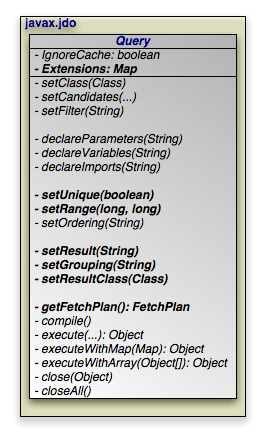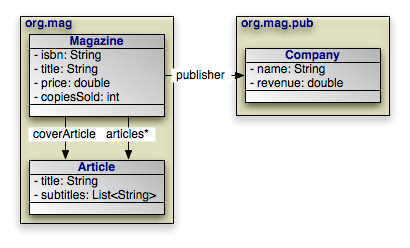
The javax.jdo.Query interface serves two functions:
object filtering and data retrieval. This chapter examines each in turn.
![[Note]](img/note.gif) | Note |
|---|---|
Kodo extends the standard |
JDO queries evaluate a group of candidate objects against a set of
conditions, eliminating the objects that don't match. We refer to
this as object filtering. The original group of
objects might be a Collection of instances
you've already retrieved, or an Extent. Recall
from Chapter 10, Extent that an Extent
represents all persistent instances of a certain class,
optionally including subclasses.
Filter conditions are specified in the JDO Query Language (JDOQL). The filtering process might take place in the datastore, or might be executed in memory. JDO does not mandate any one mechanism, and many implementations use a mixture of datastore and in-memory execution depending on the circumstances.
Basic object filtering utilizes the following Query
methods:
public void setClass (Class candidateClass); public void setCandidates (Extent candidates); public void setCandidates (Collection candidates); public void setFilter (String filter);
setClassnames the candidate class. Candidate objects that are not assignable to the candidate class cannot match the filter.The two
setCandidatesmethods specify the set of objects to evaluate. If you supply anExtent, you don't need to also callsetClass; theQueryinherits theExtent's candidate class. Reciprocally, if you callsetClassbut do not call eithersetCandidatesmethod, the query candidates default to theExtentof the candidate class, including subclasses.setFilteraccepts a JDOQL string establishing the conditions an object must meet to be included in the query results. As you'll see shortly, JDOQL looks exactly like a Java boolean expression using the candidate class' persistent fields and relations. When you don't set a filter explicitly, it defaults to the simplest possible boolean expression:true. In this case, all candidate objects assignable to the candidate class match the query.
Let's see an example of basic object filtering in action. Our example draws on the following subset of the object model defined in Chapter 5, Metadata. We use this model subset throughout this chapter.

Example 11.1. Filtering
The following code processes all Magazine
objects in the database whose price is greater than 10 dollars.
PersistenceManager pm = ...;
Query query = pm.newQuery ();
query.setClass (Magazine.class);
query.setCandidates (pm.getExtent (Magazine.class, true));
query.setFilter ("this.price > 10");
List mags = (List) query.execute ();
for (Iterator itr = mags.iterator (); itr.hasNext ();)
processMagazine ((Magazine) itr.next ());
query.close (mags);
The code above is technically correct, but could be much more
concise. First, remember that setting a candidate class defaults
the candidates to the Extent of that class,
and vice versa. So we
don't need both the setClass
and setCandidates calls. We can also get
rid of the this qualifier on price
in our filter string, since unqualified field names are
already assumed to belong to the current object, just as in Java
code. Finally, we can take advantage of the fact that
PersistenceManager overloads the
newQuery method to tighten our code
further. Here is the revised version:
PersistenceManager pm = ...;
Query query = pm.newQuery (Magazine.class, "price > 10");
List mags = (List) query.execute ();
for (Iterator itr = mags.iterator (); itr.hasNext ();)
processMagazine ((Magazine) itr.next ());
query.close (mags);
The filter above is rather basic. Before moving on to more advanced queries, though, we need to dive into the details of JDOQL.